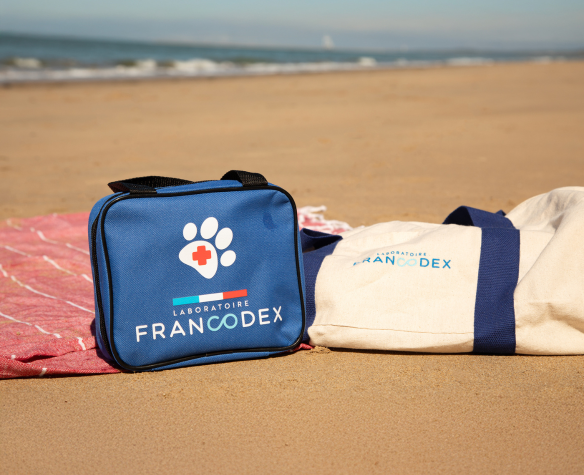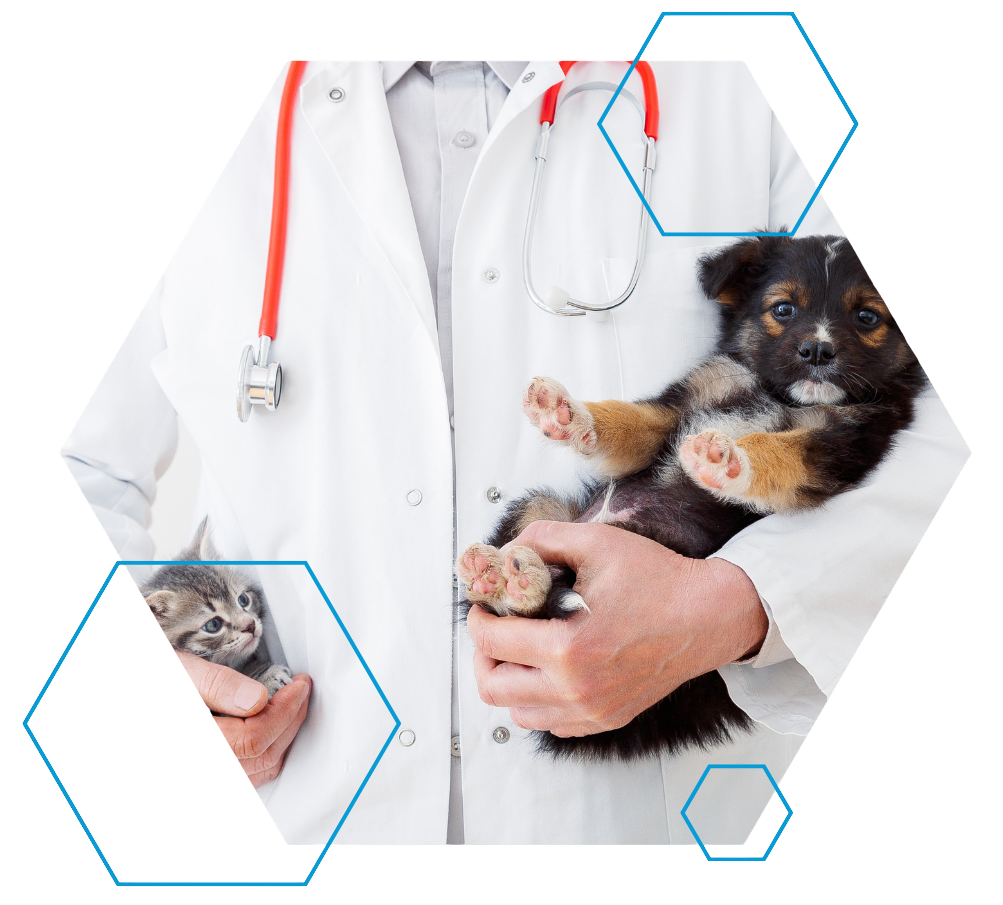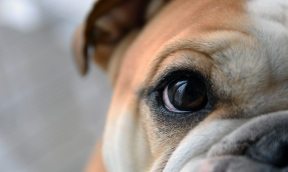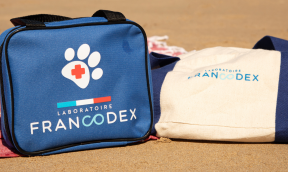
Canine and feline first aid: 11 things to do in an emergency
 Ingestion of a poisonous plant, heatstroke, tick bite, suffocation or even a burn - your dog or cat could be the victim of a domestic accident. Knowing how to perform canine and feline first aid without panicking can prevent serious complications and even save your pet's life. Francodex teaches you to adopt the right reflexes, because protecting your companion also means preparing for the worst.
Ingestion of a poisonous plant, heatstroke, tick bite, suffocation or even a burn - your dog or cat could be the victim of a domestic accident. Knowing how to perform canine and feline first aid without panicking can prevent serious complications and even save your pet's life. Francodex teaches you to adopt the right reflexes, because protecting your companion also means preparing for the worst.Why train in animal first aid?
Unlike humans, animals do not have access to structured emergency services. So it's up to its owners to intervene first.
Knowing first aid techniques allows you to:
- limit complications;
- stabilise the animal's condition;
- save time before arrival at the vet's;
- sometimes save a life.
Conversely, inappropriate action can worsen the situation or compromise your companion's chances of survival.
11 first aid tips for dogs and cats
Let's find out right now what good attitudes to adopt when faced with most accidents that can happen to your pet.
Insect bites and stings
Insect stings (bees, wasps, mosquitoes) cause redness, swelling or localised itching. They become a cause for concern if there is facial swelling, respiratory discomfort or a generalised reaction.
We recommend that you remove the sting carefully, without squeezing, and apply a cold compress locally. Do not administer any medication without veterinary advice!
After consultation, you may be able to use a soothing spray for skin irritations to relieve your pet.
Ticks, on the other hand, attach themselves to the skin and can transmit serious diseases. Remove the parasite with a pair of tick remover pliers by grasping the head of the parasite, without crushing it, and turning it gently anti-clockwise.
Disinfect the area with an antiseptic spray and watch for fever, swelling or weakness in the following days. If necessary, contact your vet.
Acute gastric disorders
While prebiotics and probiotics for dogs and cats help to keep your pet's intestinal tract comfortable, they become insufficient when gastric problems become more acute.
Repeated vomiting, excessive salivation, a hard belly, refusal to eat, restlessness or unsuccessful attempts to vomit can signal a digestive emergency, gastric torsion in dogs in particular, which is often fatal without prompt intervention.
In this case, never try to make the animal vomit. Do not give it food or water. Avoid handling it unnecessarily and take it to the vet without delay.
In cats, obstruction or pancreatitis can present similar signs. Any sudden, severe abdominal pain should be treated as a reason for immediate consultation.
Non-bleeding wounds
A fall, blow or wrong movement can result in a contusion, sprain or fracture, with no visible external signs. The animal may limp, refuse contact or adopt an unusual posture.
Start by avoiding any mobilisation of the painful area. Do not massage or bandage without veterinary advice. If a leg is affected, limit movement by carrying the animal, weight permitting.
However, you can apply a localised cold compress, an ice pack wrapped in a cloth, to limit inflammation.
Note the progress of symptoms within 48 to 72 hours. If the pain seems to persist or worsen, consult your vet.
Once you have made your diagnosis, in the event of shock or minor trauma, your vet may recommend massaging the affected area with an arnica massage gel to aid recovery.
Heat stroke
Heatstroke mainly affects dogs during intense physical effort or when they are exposed to excessive heat. Although cats are more resistant to this, they remain vulnerable in confined environments.
🐾 Find out how to keep your pet cool during the summer heat.
The signs of heatstroke in cats and dogs are alarming:
- rapid panting;
- bright red gums;
- weakness;
- vomiting;
- even convulsions.
As soon as the first symptoms appear, place the animal in the shade in a ventilated area.
Gradually cool its body with towels moistened with tepid water (never ice-cold), concentrating on its armpits and groin for more effective cooling, rather than on its paws, where the large blood vessels run.
Offer it room temperature water to drink, without forcing it and in small quantities. In fact, some dogs tend to gorge themselves on it, which can lead to "water poisoning". It is characterised by disturbances in blood homeostasis that can lead to oedema or serious cardiovascular problems.
Protect its eyes from direct light with a clean, light cloth. In summer, you can use a protective eye gel as a preventive measure if your dog or cat has dry eyes due to age or illness.
⚠️ Never immerse your dog in cold water, as the thermal shock could aggravate the situation. A veterinary consultation is essential, even if the condition improves rapidly.
Burns
Burns can be thermal (fire, hot liquid), chemical (detergents) or electrical. They manifest themselves as:
- rashes;
- blisters;
- intense pain;
- or, paradoxically, a loss of sensitivity.
Immediately cool the affected area with tepid water (15-20°C) for at least 10 minutes, without rubbing. Never puncture blisters or apply ointments or grease!
In the event of a chemical burn, rinse thoroughly with clean water, protecting your hands.
Isolate the animal to prevent it from licking itself and take it to an emergency vet.
Secondly, a repair spray with acacia honey can moisturise and soothe skin that has suffered trauma.
Haemorrhage
An external haemorrhage can quickly endanger the life of your cat or dog, particularly if it involves an artery. It manifests itself as a copious, bright red and sometimes pulsating flow of blood, accompanied by progressive weakness and even shock.
The immediate objective is to limit blood loss. Apply direct pressure with a sterile compress or clean cloth, without releasing.
If the bleeding is on a limb, gently elevate it above the level of the heart. Tourniquets should only be used in exceptional circumstances; they should be strictly temporary and reserved for major haemorrhages, and monitored regularly.
In addition, never remove an object stuck in a wound: stabilise it by wrapping it around it. Prompt veterinary intervention is essential to avoid any complications.
Choking
Choking occurs when the animal's airways are blocked by a foreign object, often a toy, bone or food.
Clinical signs of choking include:
- a dry cough;
- abundant salivation;
- difficulty breathing;
- marked agitation;
- even cyanosis of the mucous membranes.
The priority is to restore normal breathing. Start by carefully opening the animal's mouth and removing only what is clearly visible, without forcing it.
If this fails, you can apply the Heimlich manoeuvre to dogs and cats:
- for small animals, hold the animal's head down and apply gentle abdominal pressure;
- for large animals, push vigorously under the thorax, inwards and upwards.
A veterinary consultation is still essential, even if the object is expelled.

Cardiorespiratory arrest
In the event of cardiorespiratory arrest, the chances of survival are limited, even with veterinary intervention.
Cardiorespiratory arrest is manifested by the absence of breath, chest movement and pulse. It can be caused by trauma, drowning, electrocution or a severe allergic reaction. Without rapid intervention, death occurs within minutes.
Start cardiopulmonary resuscitation (CPR) immediately by placing the animal on its right side.
For dogs, give 30 chest compressions for every two breaths. In cats, apply gentler compressions closer together.
In any case, alternate massage and ventilation every 15 to 20 seconds until breathing is resumed or until veterinary intervention can be sought.
Convulsions
Convulsions involve involuntary shaking, sometimes with loss of consciousness, excessive salivation or incontinence. This can result from poisoning, epilepsy, hypoglycaemia or trauma.
Act calmly and effectively:
- keep dangerous objects away;
- dim the lights;
- do not touch the animal;
- never open its mouth to avoid being bitten;
- time the seizure, because after two minutes it becomes critical.
After the seizure, let your companion wake up calmly. Keep it warm and monitor its breathing. Consult a doctor as soon as possible to identify the cause and prevent recurrences. In fact, many convulsive seizures have a toxic origin.
Unconsciousness
An unconscious animal no longer responds to stimulation. The causes can be varied:
- shock;
- poisoning;
- heart attack.
You must quickly assess its vital functions.
If it is breathing, place it in the side-lying position, with his head tilted slightly downwards. Create a calm, subdued environment and cover it lightly to prevent hypothermia.
Do not try to wake them up, do not give them anything to eat or drink, and seek immediate medical attention for a rapid diagnosis and treatment.
Poisoning
Ingestion of toxic substances (chocolate, plants, medicines, household products) often leads to vomiting, salivation or despondency.
Never make your cat or dog vomit without veterinary advice. The passage of certain toxic products aggravates the lesions. Make a note of the substance involved and keep the packaging.
Immediately contact your vet so that your dog or cat can receive appropriate treatment.
Knowing first aid is one of the duties of an owner. To do this, you can get training from qualified professionals. You should always have a complete pet first-aid kit to hand.
You can complete it with:
- a thermometer. In the event of heatstroke or hypoglycaemia, the symptoms are similar and a temperature reading can tell the difference;
- a fabric strip or ribbon to muzzle the dog in case of pain and avoid being bitten;
- a survival blanket (especially useful in the cold);
- honey or sugar in the event of hypoglycaemia (sport, hiking, etc.);
- a small torch or headlamp for night-time "interventions", although a telephone flashlight can also be used.
When it comes to first aid, it's preparation, not improvisation, that makes the difference!
Put together a first aid kit for my pet
Article written with the assistance of
Dr Marie MAROSSERO, Veterinary Surgeon




